

With housing construction and rehabbing booming, you, along with other hardwood flooring contractors, may be thinking of purchasing a first computer system or replacing an old one.
But, before you buy, you should be aware that some of your fellow business owners have suffered computer-purchase problems ranging from excessively late delivery of the systems to not getting the promised software features. Many of these problems could have been avoided had the business owners not made mistakes in buying and installing the systems. Here are common mistakes to avoid and good steps to take to select a system that is just right for your small to mid-size contracting business.
M.I.A.
Some owners of contracting businesses believe that anything involving a computer is best left to a "computer person." This sometimes means that the boss's son or daughter, or someone else who doesn't actually work for the company, is brought in to do the dirty work. When it comes to selecting a computer system, though, the person who knows the business best—the boss—should not be missing in action. Most successful military campaigns resulted from the leadership of a general, even if he remained well behind the front lines. So, if the effort to select and install a new system is to be successful, the business owner must provide the leadership and be actively involved in selecting it. For owners who are uneducated about computers, it can be helpful to read a book about computer systems for businesses. One that deals with systems for contractors would be ideal, as it would provide details about the functions outlined in the sidebar "Necessary Functions for Contractor Computer Systems".
Just as bad as the boss not being involved is one who does everything himself, or assigns the job exclusively to another person. Victory has many fathers, but defeat is an orphan. To achieve the victory of an effective system, form a team of "fathers" from throughout the company. In smaller companies, put everyone—including your sanding and finishing crews—on the team, and involve them from the beginning. This step is essential in getting people to actively contribute ideas, emotion and time, all of which are necessary for success.
The Battle Plan
Before creating a list of features that should be a part of the computer system, not to mention doing any shopping, estimate how much the company is likely to grow and/or change over the next five years. This step is vital, because the system being purchased should be able to handle future as well as current needs. For example, if more office employees are likely to be added, the computer should be large enough or expandable enough to allow all office employees to use it at the same time. Or, if your company is starting to take on a higher volume of large or commercial jobs, an estimating function, which may not be needed right away, could be helpful.
Once you have an idea of where your company is headed as far as growth and change, you can further define your needs by contacting vendors of computer systems for contractors and requesting literature. You can find names of vendors by calling other contractors, checking the local Yellow Pages, going to computer and electronics superstores, or even searching the Internet with the keywords "software for contractors."
Use the literature from these vendors to create a list of necessary computer functions, then divide the list into two categories: immediate needs and future needs (based on likely growth and changes). Make this second list as detailed as possible. If you are in doubt as to whether a function needs to be on your list, add it. Without this list of functions, it's impossible to judge whether or not a particular software package contains needed functions or allows functions (e.g., general ledger) to be easily added later. A list like this also is invaluable when it comes to understanding vendor quotes and comparing computer systems—since no two look alike. Finally, a detailed list of needed functions helps avoid "horror story" systems and vendors that don't do what you assumed they would.
Marching Orders
After creating your detailed list of essential computer functions, the next most important step is to ask system vendors to compare their software against the list—in writing—before any demonstrations. Always get a written, detailed quotation from each vendor that addresses your list and issues such as hardware expandability, the cost of installation services, the cost of an annual support contract and the cost of adding more users in the future.
All too frequently, business owners neglect to ask vendors to make a features comparison, because they assume that the list of needed functions can be used during system demonstrations. Although some necessary functions can be addressed during a product demo, there isn't enough time in a demo to check out every feature. Without a comparison, there is no way to know if the software will fit your company's needs in every detail. This leaves your company vulnerable to problems that can only be discovered after the system is put into use—when it's too late.
Scout It Out
Never select a computer system solely on the basis of observing demonstrations, and likewise, never base decisions only on vendor quotes. Instead, find a balance between demonstrations and detailed written quotes. As has been established, without a written quote, not all features necessary to your company can be addressed, but without a demo, it is impossible to judge if a system has an acceptable look and feel, and if the various features are practical to use. For a demo to be worthwhile, ask each vendor to demonstrate the features that are important to your company, even if it's a quick one-hour demo (four to eight hours is really needed to understand any system).
After all the demos, the team should decide which system or systems are worth investigating further and then call a few references of the selected vendor or vendors. When calling references, ask questions about hardware reliability; the vendor's track record in helping convert to the new system; the vendor's ability to provide post-installation support; and, of course, whether the software's features are easy to use and improve the way the business operates.
After phone reference checks are completed, the team should decide which system or systems are worth a visit. Not every reference for the selected vendors need be visited, but never arrange a visit without first doing a telephone reference check; some references are so different in size and business operations that a visit would be a waste of time. It is important to visit at least one contractor using the system you are considering before you decide to buy it.
One of the dangers of picking a system just by observing demos is that team members can be sold on a system because they like the salesperson and system, not because they consider all the facts. The biggest fact to consider is the long-term cost of ownership—initial plus ongoing costs.
Ongoing costs can seem small relative to the initial cost of a system, but multiply a small cost by five or seven, and the resulting number can be much larger than the up front investment.
Other facts to weigh include: the degree to which the software fits your business's needs; the extent of vendor education and training; data conversion (from the old system); installation and post-installation support capabilities; and feedback from reference phone calls and visits. Many of these facts can be obtained only by studying a written response to the questions created before shopping.
The big decision must be made by taking both financial and non-financial facts into account. Sometimes, a slick system and vendor are not worth the extra cost, or are not worth the risk of a rough conversion or potentially weak post-installation support.
Divide and Conquer
No matter how comfortable the team feels about the selected vendor and computer system, changing systems is so complex that many things can go wrong during installation and for years after installation; even moreso for a first system. Yet, no vendor contract protects a buyer against potentially severe problems, because vendor contracts contain vague "best efforts" terms and disclaimers of responsibility or contain money-back guarantees that are useless when problems occur well after going live. A protective contract helps avoid problems by containing specific performance guarantees, listing everything the vendor is promising and detailing everything the team is expecting.
A good protective contract will cover:
- exact listings of what is being provided and at what cost
- payments tied to results
- target dates
- what happens if there is excessive vendor lateness on delivery or poor support during installation
- what happens if there are problems with hardware performance
- what the vendor will do if postinstallation support is inadequate
- warranties.
The team leader should modify the vendor's contract to incorporate language that addresses those protective issues and send the document to the vendor. If the vendor refuses to even negotiate the changes, find another vendor. If the vendor objects to certain changes, the team leader should ask the vendor to explain why and to suggest an alternative. Be prepared to compromise, but don't compromise too much on issues dealing with problems that are likely to occur or problems that would have a negative impact if they did occur.
Reporting for Duty
No matter how vigorously the selected vendor says they don't want to create special (extra cost) reports until the system is in full use for a few months, don't wait. Have the reports created before going live—before the vendor is paid for the system. Business owners who wait to have special reports made often find they are then too busy to help define the reports, or the vendor is too busy to create reports; and employees live without the reports or work around them, which wastes time. When each report is first printed, someone should verify that all expected detail is there and correct, and that subtotals and totals are correct.
Also, many companies assume that all the data on the old system can be electronically converted to the new system so automatically that it can be used without any proofing. Similarly, people assume that files built from scratch need no proofing. Unfortunately, electronic file conversion usually is not nearly as fast and clean as expected, and files created manually also can contain many errors. Because of the probability of there being incorrect data in new files, personnel should plan on spot-checking each file, regardless of how it is built. And, whenever possible, they should use control totals to verify total conversion. For example, they should calculate the total owed from both the old and new accounts receivable file—the two numbers must match to the penny, or there is an error somewhere. Don't delegate this job to vendor personnel; they don't know the business and can't judge if data is converted correctly or is accurate.
Boot Camp
Because the cost of a system often produces sticker shock, most businesses ask for a discount on hardware and software and cut back as much as possible on related services such as training.
That's a big mistake. Today's systems are so complex that there is much more to learn than there was with the system being replaced. And, the only way to learn more is to spend more time in formal classes and on-site training sessions, all of which cost more than most business owners expect.
At a minimum, adequate training means that at least two people learn about each functional area (e.g., payroll or estimating), although not necessarily the same two people for each area. Only after this minimum training are employees ready to use the "train the trainer" approach—those who learn first teach others.
By following these basic steps, you can select a successful computer system that will provide you and your business with years of good service. A computer system is only as good as the work you put into researching, understanding and using it—the more involved you are in the process from selection to training to end use, the more you will get out of it.
Necessary Functions for Contractor Computer Systems
• Estimating:
- for a job or by job section, select type of labor (from pre-defined drop-down list), then enter estimated hours
- select type of material (from pre-defined list), then enter quantity (and unit cost, if not on file)
- enter direct job expenses (e.g., rental of equipment), job mark-up % and labor rates (if not on file)
- system calculates material, labor and direct job expenses, and overheadcost allowance, and suggests price of job (which user can override)
• Payroll:
- per job and day, enter regular and overtime hours for hourly and salaried employees
- enter pay rates (if not already on file)
- system calculates gross wages and deductions/withholdings, job charges and any union payments
- system prints checks and government/union reports
• Purchasing:
- enter purchase order data, including job number and list of items being bought from that vendor
- when items are received (at shop or job site), enter item code number and quantity received - system prints POs and report of charges to each job (using costs on PO), and tracks open POs
• Inventory Control:
- for materials, sundries and equipment, system tracks quantities on hand (usually at shop, but also in each truck) and on order (via PO)
- system prints alert lists when on-hand quantities get low
• Accounts Payable:
- system verifies vendor invoices against receiving data - system tracks open payables
- system consolidates invoice data for each vendor, then prints checks and posts to general ledger
• Accounts Receivable:
- enter job data, and print (full or partial) invoices and register
- system updates general ledger and job data; tracks open invoices
- system applies customer payments to invoices and updates job data
- system prints report of job charges not yet billed and aging of receivables
• General Ledger:
- system tracks assets, liabilities, income and expenses
- system prints financial reports: profit/loss, balance sheet, cash flow source and uses
• Profitability Reporting:
- prints reports for open and complete jobs, comparing estimated to actual labor, material and direct job expenses
- prints report comparing applied overhead (applied when labor and materials are charged to job) to year-to-date actual expenses
- system creates reports by job and prints profit/loss to date
• Cost to Complete:
- for each open job, enter % complete (by section where applicable) - system estimates hours required to complete the job (section)
- system prints reports comparing initial estimated hours to latest estimate of hours to complete
• Tools and Equipment (for vehicles and other expensive equipment):
- system tracks usage (e.g., hours or miles) and prints preventive maintenance alerts (based on "triggers" previously placed on file)
- system tracks preventive maintenance and service charges, and print lifecycle cost reports
































